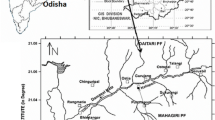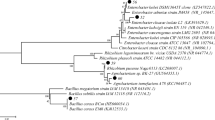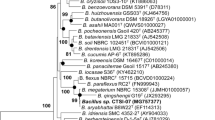Abstract
The Cr6+-resistant plant growth-promoting bacteria was isolated from soil samples that were collected from an electroplating industry at Coimbatore, India, that had tolerated chromium concentrations up to 500 mg Cr6+/L in Luria-Bertani medium. Based on morphology, physiology, and biochemical characteristics, the strain was identified as Bacillus sp. following the Bergey's manual of determinative bacteriology. Evaluation of plant growth-promoting parameters has revealed the intrinsic ability of the strain for the production of indole-3-acetic acid (IAA), siderophore, and solubilization of insoluble phosphate. Bacillus sp. have utilized tryptophan as a precursor for their growth and produced IAA (122 μg/mL). Bacillus sp. also exhibited the production of siderophore that was tested qualitatively using Chrome Azurol S (CAS) assay solution and utilized the insoluble tricalcium phosphate as the sole source of phosphate exhibiting higher rate of phosphate solubilization after 72 h of incubation (1.45 μg/mL). Extent of Cr6+ uptake and accumulation of Cr6+ in the cell wall of Bacillus sp. was investigated using atomic absorption spectrophotometer and scanning electron microscope-energy dispersive spectroscopy, respectively. The congenital capability of this Cr6+-resistant plant growth-promoting Bacillus sp. could be employed as bacterial inoculum for the improvement of phytoremediation in heavy metal contaminated soils.







Similar content being viewed by others
References
Rajkumar, M., Nagendran, R., Lee, K. J., Lee, W. H., & Kim, S. Z. (2006). Influence of plant growth promoting bacteria and Cr6+ on the growth of Indian mustard. Chemosphere, 62, 741–748.
Ishibashi, Y., Cervantes, C., & Silver, S. (1990). Chromium reduction in Pseudomonas putida. Applied and Environmental Microbiology, 56, 2268–2270.
Rajkumar, M., Ma, Y., & Freitas, H. (2008). Characterization of metal-resistant plant-growth promoting Bacillus weihenstephanensis isolated from serpentine soil in Portugal. Journal of Basic Microbiology, 48, 500–508.
Cunningham, S. D., Berti, W. R., & Huang, J. W. (1995). Phytoremediation of contaminated soils. Trends in Biotechnology, 13, 393–397.
Ma, Y., Rajkumar, M., Vicente, J. A. F., & Freitas, H. (2011). Inoculation of Ni-resistant plant growth promoting bacterium Psychrobacter sp. strain srs8 for the improvement of nickel phytoextraction by energy crops. International Journal of Phytorem, 13, 126–139.
Blaylock, J. M., Salt, D. E., Dushenkov, S., Zakharova, O., Gussman, C., Kapulnik, Y., et al. (1997). Enhanced accumulation of Pb in Indian mustard by soil-applied chelating agents. Environmental Science and Technology, 31, 860–865.
Puschenreiter, M., Stoger, G., Lombi, E., Horak, O., & Wenzel, W. W. (2001). Phytoextraction of heavy metal contaminated soils with Thlaspi goesingense and Amaranthus hybridus: Rhizosphere manipulation using EDTA and ammonium sulfate. Journal of Plant Nutrition and Soil Science, 164, 615–621.
Rajkumar, M., & Freitas, H. (2008). Effects of inoculation of plant-growth promoting bacteria on Ni uptake by Indian mustard. Bioresource Technology, 99, 3491–3498.
Burd, G. I., Dixon, D. G., & Glick, B. R. (2000). Plant growth promoting bacteria that decreases heavy metal toxicity in plants. Canadian Journal of Microbiology, 46, 237–245.
Wang, P. C., Mori, T., Komori, K., Sasatsu, M., Toda, K., & Ohtake, H. (1989). Isolation and characterization of an Enterobacter cloacae strain that reduces hexavalent chromium under anaerobic conditions. Applied and Environmental Microbiology, 55, 1665–1669.
Puppi, G., Azcón, R., & Höflich, G. (1994). Management of positive interactions of arbuscular mycorrhizal fungi with essential groups of soil microorganisms. In S. Gianinazzi & H. Schüepp (Eds.), Impact of arbuscular mycorrhizas on sustainable agriculture and natural ecosystems (pp. 201–215). Basel: ALS, Birkhäuser-Verlag.
Whiting, S. N., de Souza, M. P., & Terry, N. (2001). Rhizosphere bacteria mobilize Zn for hyperaccumulation by Thlaspi caerulescens. Environmental Science and Technology, 15, 3144–3150.
Glick, B. R., Patten, C. L., Holguin, G., & Penrose, G. M. (1999). Biochemical and genetic mechanisms used by plant growth promoting bacteria. London: Imperial College.
Rajkumar, M., Ae, N., Prasad, M. N. V., & Freitas, H. (2010). Potential of siderophore producing bacteria for improving heavy-metal phytoextraction. Trends in Biotechnology, 28, 142–149.
Rajkumar, M., Nagendran, R., Lee, K. J., & Lee, W. H. (2005). Characterization of a novel Cr6+ reducing Pseudomonas sp. with plant growth-promoting potential. Current Microbiology, 50, 266–271.
Dworkin, M., & Foster, J. (1958). Experiments with some microorganisms which utilize ethane and hydrogen. Journal of Bacteriology, 75, 592–601.
Holt, J. G., Krieg, R. N., Sneath, P. H. A., Staley, J. T., & William, S. T. (1994). Bergey's manual of determinative bacteriology (9th ed.). Philadelphia: Lippincott William & Wilkins.
Bric, J. M., Bostock, R. M., & Silversone, S. E. (1991). Rapid in situ assay for indole acetic acid production by bacteria immobilization on a nitrocellulose membrane. Applied and Environmental Microbiology, 57, 535–538.
Schwyn, B., & Neilands, J. B. (1987). Universal chemical assay for detection and determination of siderophores. Analytical Biochemistry, 160, 47–56.
Sundara-Rao, W. V. B., & Sinha, M. K. (1963). Phosphate dissolving microorganisms in the soil and rhizosphere. Indian Journal of Agricultural Sciences, 33, 272–278.
Fiske, C. H., & Subbarow, Y. (1925). A colorimetric determination of phosphorus. Journal of Biological Chemistry, 66, 375–400.
Jacobson, C. B., Pasternak, J. J., & Glick, B. R. (1994). Partial purification and characterization of ACC deaminase from the plant growth promoting rhizobacteruim Pseodomonas putida GR12-2. Canadian Journal of Microbiology, 40, 1019–1025.
Hasnain, S., Yasmin, S., & Yasmin, A. (1993). The effects of lead resistant pseudomonads on the growth of Triticum aestivum seedlings under lead stress. Environmental Pollution, 81, 179–184.
Freitas, H., Prasad, M. N. V., & Pratas, J. (2004). Analysis of serpentinophytes from north-east of Portugal for trace metal accumulation-relevance to the management of mine environment. Chemosphere, 54, 1625–1642.
Pal, A., Dutta, S., Mukherjee, P. K., & Paul, A. K. (2005). Occurrence of heavy metal-resistance in microflora from serpentine soil of Andaman. Journal of Basic Microbiology, 45, 207–218.
Abou-Shanab, R. A., Van Berkum, P., & Angle, J. S. (2007). Heavy metal resistance and genotypic analysis of metal resistance genes in gram-positive and gram-negative bacteria present in Ni-rich serpentine soil and in the rhizosphere of Alyssum murale. Chemosphere, 68(2), 360–367.
Glick, B. R., Penrose, D. M., & Li, J. (1998). A model for the lowering of plant ethylene concentrations by plant growth promoting bacteria. Journal of Theoretical Biology, 190, 63–68.
Gupta, A., Meyer, J. M., & Goel, R. (2002). Development of heavy metal resistant mutants of phosphate solubilizing Pseudomonas sp. NBRI4014 and their characterization. Current Microbiology, 45, 323–327.
Garcia de Salamone, I. E., Hynes, R. K., & Nelson, L. N. (2001). Cytokinin production by plant growth promoting rhizobacteria and selected mutants. Canadian Journal of Microbiology, 47, 103–113.
Xie, H., Pasternak, J. J., & Glick, B. R. (1996). Isolation and characterization of mutants of the plant growth-promoting rhizobacterium Pseudomonas putida GR12-2 that over produce indole acetic acid. Current Microbiology, 32, 67–71.
Dell’Amico, E., Cavalca, L., & Andreoni, V. (2005). Analysis of rhizobacterial communities in perennial Graminaceae from polluted water meadow soil, and screening of metal-resistant, potentially plant growth-promoting bacteria. FEMS Microbiology Ecology, 52, 153–162.
Atkin, C. L., Neilands, J. B., & Phaff, H. J. (1970). Rhodotorulic acid from species of Leucosporidium, Rhodosporidium, Rhodotorula, Sporidiobolus, and Sporobolomyces, and a new alanine-containing ferrichrome from Cryptococcus melibiosum. Journal of Bacteriology, 103, 722–733.
Drechsel, H., Tschierske, M., Thieken, A., Jung, G., Zahner, H., & Winkelmann, G. (1995). The carboxylate type siderophore rhizoferrin and its analogues produced by directed fermentation. Journal of Industrial Microbiology, 14, 105–112.
Evers, A., Hancock, R. D., Martell, A. E., & Motekaitis, R. J. (1989). Metal ion recognition in ligands with negatively charged oxygen donor groups. Complexation of Fe(III), Ga(III), In(III), Al(III) and other highly charged metal ions. Inorganic Chemistry, 28, 2189–2195.
van der Lelie, D., Corbisier, P., Diels, L., Gilis, A., Lodewyckx, C., Mergeay, M., et al. (1999). The role of bacteria in the phytoremediation of heavy metals. In N. Terry & G. Banuelos (Eds.), Phytoremediation of contaminated soil and water (pp. 265–281). London: Lewis Publishers.
Mishra, D., & Kar, M. (1974). Nickel in plant growth and metabolism. The Botanical Review, 40, 395–452.
Crowley, D. E., Reid, C. P. P., & Szaniszlo, P. J. (1988). Utilization of microbial siderophores in iron acquisition by oat. Plant Physiology, 87, 680–685.
Zaidi, S., Usmani, S., Singh, B. R., & Musarrat, J. (2006). Significance of Bacillus subtilis strain SJ-101 as a bioinoculant for concurrent plant growth promotion and nickel accumulation in Brassica juncea. Chemosphere, 64, 991–997.
Cunningham, J. E., & Kuiack, C. (1992). Production of citric and oxalic acids and solubilization of calcium phosphate by Penicillium billai. Applied and Environmental Microbiology, 52, 1451–1458.
Bar-Yousef, B., Rogers, R. D., Wolfram, J. H., & Richman, E. (1999). Pseudomonas cepacia-mediated rock phosphate solubilization in kaolinite and montmorillonite suspensions. Soil Science Society of America Journal, 63, 1703–1708.
Bano, N., & Mussarat, J. (2003). Isolation and characterization of phorate degrading soil bacteria of environmental and agronomic significance. Letters in Applied Microbiology, 36, 349–353.
Ma, Y., Rajkumar, M., & Freitas, H. (2009). Inoculation of plant growth promoting bacterium Achromobacter xylosoxidans strain Ax10 for the improvement of copper phytoextraction by Brassica juncea. Journal of Environmental Management, 90, 831–837.
Halstead, R. L., Finn, B. J., & MacLean, A. J. (1969). Extractability of nickel added to soils and its concentration in plants. Canadian Journal of Soil Science, 49, 335–342.
Johncy Rani, M., Hemambika, B., Hemapriya, J., & Rajesh Kannan, V. (2010). Comparative assessment of heavy metal removal by immobilized and dead bacterial cells: A biosorption approach. African Journal of Environmental Science and Technology, 4(2), 77–83.
Sag, Y., Ozer, D., & Kutsal, T. (1995). A comparative study of the biosorption of Pb(II) ions to Z. ramigera and R. arrhitus. Process Biochemistry, 30, 169–174.
Tsekova, K., & Ilieva, S. (2001). Copper removal from aqueous solution using Aspergillus niger mycelia in free and polyurethane bound form. Applied Microbiology and Biotechnology, 42, 636–637.
Hemambika, B., Johncy Rani, M., & Rajesh Kannan, V. (2011). Biosorption of heavy metals by immobilized and dead fungal cells: A comparative assessment. Journal of Ecology and the Nature Environment, 3(5), 168–175.
Alam, M. Z., & Ahmad, S. (2011). Chromium removal through biosorption and bioaccumulation by bacteria from tannery effluents contaminated soil. Clean - Soil, Air, Water, 39, 226–237.
Beveridge, T. J. (1988). The bacterial surface: General considerations towards design and function. Canadian Journal of Microbiology, 34, 363–372.
Mullen, M. D., Wolf, D. C., Ferris, F. G., Beveridge, T. J., Flemming, C. A., & Bailey, G. W. (1989). Bacterial sorption of heavy metals. Applied and Environmental Microbiology, 55, 3143–3149.
Tobin, J. M., Cooper, D. G., & Neufeld, R. J. (1984). Uptake of metal ion by Rhizopus arrhizus biomass. Applied Microbiology, 47, 821–824.
Zhou, J. L. (1999). Zn biosorption by Rhizopus arrhizus and other fungi. Applied Microbiology and Biotechnology, 51, 686–693.
Delorme, T. A., Gagliardi, J. V., Angle, J. S., & Chaney, R. L. (2001). Influence of the zinc hyperaccumulator Thlaspi caerulescens J. & C. Presl. and the nonmetal accumulator Trifolium pratense L. on soil microbial population. Canadian Journal of Microbiology, 67, 190–197.
Goodhew, P. J., Humphreys, J., & Beanland, R. (2001). Electron microscopy and analysis (3rd ed.). UK: Taylor and Francis.
Konstantinidis, K. T., Isaacs, N., Fett, J., Simpson, S., Long, D. T., & Marsh, T. L. (2003). Microbial diversity and resistance to copper in metal-contaminated lake sediment. Microbial Ecology, 45, 191–202.
He, H., Dong, X., Yang, M., Yang, Q., & Duan, S. (2004). Catalytic inactivation of SARS coronavirus, Escherichia coli and yeast on solid surface. Catalysis Communications, 3, 170–172.
Asku, Z., Kutsal, T., Gun, S., Haciosmanoglu, N., & Gholminejad, M. (1991). Investigation of biosorption of Cu (II), Ni (II) and Cr (VI) ions to activated sludge bacteria. Environmental Technology, 12, 915–921.
Wong, P. K., Lam, K. C., & So, C. M. (1993). Removal and recovery of Cu (II) from industrial effluent by immobilization cells of Pseudomonas putida II-11. Applied Microbiology and Biotechnology, 39, 127–131.
Zolgharnein, H., Karami, K., Mazaheri Assadi, M., & Dadolahi Sohrab, A. (2010). Investigation of heavy metals biosorption on Pseudomonas aeruginosa strain MCCB 102 isolated from the Persian gulf. Asian Journal of Biotechnology, 2(2), 99–109.
Author information
Authors and Affiliations
Corresponding author
Rights and permissions
About this article
Cite this article
Hemambika, B., Kannan, V.R. Intrinsic Characteristics of Cr6+-Resistant Bacteria Isolated from an Electroplating Industry Polluted Soils for Plant Growth-Promoting Activities. Appl Biochem Biotechnol 167, 1653–1667 (2012). https://doi.org/10.1007/s12010-012-9606-y
Received:
Accepted:
Published:
Issue Date:
DOI: https://doi.org/10.1007/s12010-012-9606-y




